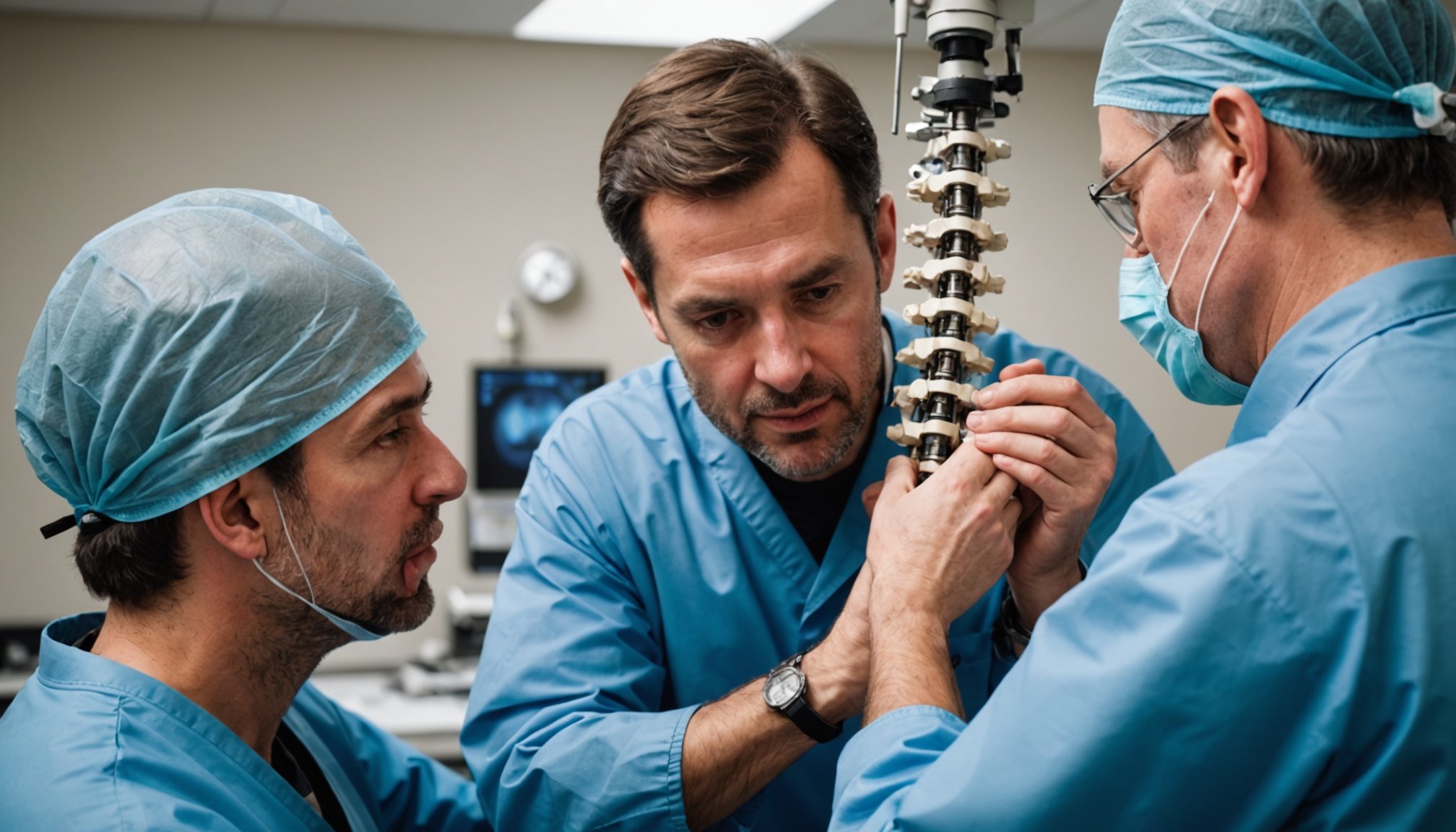Overview of Minimally Invasive Spine Surgery
Minimally invasive spine surgery (MISS) represents innovative surgical methods in the field of orthopedics, fundamentally altering spine treatment approaches. As opposed to traditional open surgery, MISS employs small incisions, often aided by endoscopic technology or microscopic assistance. These techniques limit damage to the surrounding muscles and tissues, leading to quicker recovery and reduced postoperative complications.
Orthopedic surgeons in the UK are increasingly adopting these methods, driven by advancements and the demand for less invasive procedures. The country’s seasoned professionals are at the forefront of utilizing these techniques to improve patient care and outcomes. The scope of these surgeries ranges from addressing degenerative disk disease to correcting spinal deformities, showcasing their versatility.
Also to discover : Unveiling the essential impact of uk public health leaders in addressing health issues arising from climate change
Patients opting for minimally invasive techniques often include younger demographics keen on speedy recoveries and older patients with conditions like herniated discs or spinal stenosis. These individuals seek out such procedures to maintain their active lifestyles and avoid the lengthy recovery periods associated with traditional methods. As a result, the need for continuous innovation in orthopedic practices grows, pushing for advancements that align with patient expectations for efficient and effective treatments.
Latest Techniques in Minimally Invasive Spine Surgery
The realm of minimally invasive spine surgery is continuously evolving with cutting-edge surgical techniques designed to enhance patient care. Among these advancements, endoscopic spine surgery stands out, offering a detailed view of the spine through tiny incisions. This method minimises muscle disruption, reducing recovery time significantly. It is particularly appealing due to its ability to mitigate postoperative pain, though it requires specialised equipment and training.
Also read : Revolutionizing cancer detection: innovative imaging techniques used by uk radiologists
Another promising innovation is robotic-assisted surgery. This approach integrates robotics into orthopedic practices, allowing for unparalleled precision in surgical executions. Robotic systems assist surgeons in making exact cuts, thus enhancing surgical outcomes. However, the cost implications and learning curve associated with this technology can be a barrier to its widespread adoption among UK orthopedic surgeons.
Intradiscal procedures represent a less invasive means to address spinal issues like herniated discs. These techniques focus on treatment within the disc space, preserving much of the surrounding tissue. The main advantage here lies in preserving spinal stability, yet it might not be suitable for all spinal conditions.
Overall, these advanced orthopedic methods are gradually gaining traction, with UK-based surgeons leveraging them to offer superior patient outcomes while addressing the intricacies of spine surgery innovations.
Benefits of Minimally Invasive Spine Surgery
Minimally invasive spine surgery is advancing as a preferred choice due to its myriad benefits. A standout advantage is the reduced recovery time. Patients typically experience fewer days in the hospital compared to those undergoing traditional surgery. This aspect alone significantly contributes to an expedited return to daily activities, essential for those maintaining active lifestyles. Moreover, the lower postoperative pain associated with these techniques means reduced reliance on pain medications and decreased likelihood of complications such as infections.
In addition to improved recovery and comfort, long-term patient outcomes reflect these advantages. Enhanced functional outcomes result from the preservation of surrounding musculature, crucial for maintaining spine stability and overall mobility. This aspect of minimally invasive surgery often leads to higher levels of patient satisfaction, as individuals recover faster without sacrificing quality of life.
The appeal of minimally invasive techniques is reinforced by their ability to produce effective surgical outcomes while keeping patient discomfort to a minimum. These characteristics of minimally invasive surgery are driving its rapid adoption, particularly as patients become increasingly informed about available surgical options and seek treatments that align with their goals for minimal disruption and maximal efficacy.
Comparative Analysis with Traditional Spine Surgery
When comparing traditional spine surgery to its minimally invasive counterpart, differences in surgical outcomes reveal significant advantages. Traditional methods often involve larger incisions, potentially leading to longer recovery times and increased risk of infection. In contrast, minimally invasive procedures have shown higher success rates, attributed to reduced tissue damage and minimized surgical trauma.
Success Rates
Studies indicate that minimally invasive techniques have comparable, if not higher, success rates than traditional methods. This success is often measured through lower complication rates and quicker recovery profiles, which appeal to diverse patient demographics. Success is particularly evident in patients needing spinal fusion or correction of deformities, where precision and minimal disruption are crucial.
Patient Recovery Profiles
Patient recovery profiles differ extensively between the two approaches. Those undergoing minimally invasive procedures typically resume daily activities more rapidly, experiencing less postoperative pain. By preserving muscle integrity, these techniques support faster functional recovery and overall patient satisfaction.
Long-term Outcomes
Analysing the long-term outcomes highlights the consistent benefits of minimally invasive surgery. Patients have reported sustained relief from pain and improved mobility, often without the complications associated with traditional surgery. Experts advocate for the advancement of minimally invasive methods, anticipating further evolution in best practices and patient care.
Real-Life Case Studies
Exploring real-life case studies reveals the transformative impact of minimally invasive surgery on patient experiences and outcomes. These success stories not only highlight the advanced capabilities of orthopedic surgeons in the UK, but they also serve as inspirational examples of how innovative surgical methods can reshape lives.
In one case, a middle-aged patient with spinal stenosis achieved remarkable recovery post-surgery. The use of minimally invasive spine surgery techniques enabled a quick return to normal activities, with the patient experiencing much less pain than anticipated. Testimonials from patients consistently underscore the reduced recovery times and minimal disability, contributing to an overall high satisfaction rate.
Surgeon insights further inform these narratives, pointing out that such surgeries are becoming the gold standard for those who prioritize swift rehabilitation. Patient experiences often emphasize the importance of informed decision-making and the pivotal role of tailored surgical approaches. This aligns with the growing need for procedures that accommodate diverse patient lifestyles while maximizing surgical efficacy.
Additionally, these case studies hint at potential future practices in UK orthopedics, suggesting a continued shift towards adopting less invasive, more patient-centric techniques. This adjustment promises enhancements in patient care and expands possibilities within the realm of spine surgery.
The Role of Expert Opinions in Advancing Techniques
In the evolving landscape of minimally invasive spine surgery, the collective insights of orthopedic expert opinions play a pivotal role in shaping surgical advancements. By engaging in interviews with leading surgeons, we gain invaluable perspectives on their practical experiences and insights. Such discussions often reveal nuanced understanding, offering clarity on the efficacy of innovative methods and emerging trends within the field.
Additionally, research contributions from esteemed institutions significantly influence current and future techniques. Scholarly findings provide a foundation for improving surgical practices and inform the development of novel approaches. As research progresses, it solidifies confidence in surgical advancements by substantiating the benefits and addressing challenges associated with new methodologies.
Exploring the collaborative dimension, collaborative efforts in orthopedic innovation forge pathways for breakthroughs in minimally invasive methods. Interdisciplinary partnerships enhance the scope of techniques available to orthopedic surgeons in the UK, ultimately optimizing patient outcomes. Such collaborations pool knowledge and resources, fostering an environment conducive to the continuous evolution of surgical strategies.
In summary, understanding the roles of experts and research in advancing orthopedic practices reveals the influential dynamics that drive the innovation necessary to align with patient needs and expectations.

